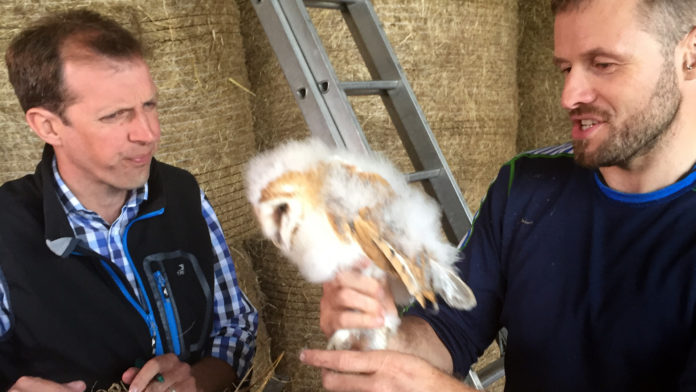
A farmer from Fermoy will feature on RTE’s Ear To The Ground programme later this month, after discovering three young barn owls nesting at his hay barn.
While moving bales in his hayshed this summer, farmer Denis Noonan noticed something moving in the corner of the shed. On closer inspection, he discovered three white fluffy barn owl chicks.
He called Birdwatch Ireland and neighbouring farmer and Birdwatch Ireland member Donal Sheehan, also came to help.
They replaced the bales and monitored the nest, while the adult birds returned at night with rodents to feed their young.
“He thought it was plastic bags between the bales but when he moved them, he found it was young owls and some dead rodents the parent owls had brought them to eat,” Donal said.
“The bales were stacked four high and the chicks were right down the bottom. It’s unusual to find owls nesting in among bales, they tend to choose disused chimneys or hollow trees,” Donal explained.
A tiny tracking device was then fitted to the male parent bird for 10 days. This involved catching it in a mist net near the nest and recapturing it 10 days later to remove the tracker and download the data. Positioning fixes were logged regularly so that all of its movements could be recorded.
Just over 6km was the furthest the male adult travelled to hunt, but most travelling was done within three kilometres of the nest. Despite attaching the device, the bird was back to the nest an hour afterwards with prey.
The most number of deliveries in one night was 25, with 10-15 being the average. Hunting for the owl began at dusk and continued until first light.
John Lusby, Raptor Conservation Officer with Birdwatch Ireland, visited the nest to leg ring the chicks. This involved placing a metal ring on their legs to ascertain their age and movements in the future.
The barn owl is one of the most recognisable farmland birds of prey but, because of their nocturnal habits, very few of us ever see them in the wild.
John estimates that there are just 400 pairs in the country and, with the help of miniature satellite tracking devices, is studying their hunting patterns.
The programme will feature on RTE One next Thursday, November 30 at 8.30pm.







